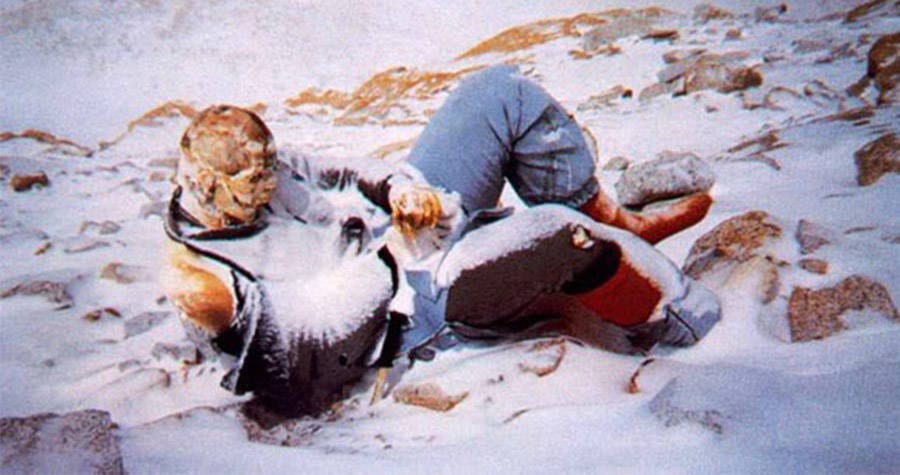Mount Everest was named after Sir George Everest despite his lack of connection to the mountain and against his wishes. He opposed the naming due to the difficulties in writing “Everest” in Hindi and the difficulty in pronunciation for local people. in fact, he never got to see with his own eyes the mountain that […]
Goran Kropp rode a bicycle 6,000 miles…
Goran Kropp rode a bicycle 6,000 miles from Stockholm to the base of Mount Everest in 1996 with his mountain equipment, successfully climbed it solo and without bottled oxygen, and then cycled back home.
The post Goran Kropp rode a bicycle 6,000 miles… appeared first on Crazy Facts.
Ten Tons of Trash Have Been Brought down from the Slopes of Mount Everest
The “highest dumpster in the world” recently had a big clean out.
More good news: the trash is getting upcycled into goods for homes and hotels all over Kathmandu.
Everest had a serious trash problem – thousands of climbers were bringing stuff up that they weren’t taking down with them. Nepal recently forbid single-use plastic in the area to try and prevent the issue from recurring.
Nepal is banning single-use plastic on and around Mount Everest in a bid to cut down on the region's trash problem. https://t.co/0iRv8E0P1D
— CNN (@CNN) August 22, 2019
Now, empty cans, bottles, canisters and abandoned camping materials are finding new life as drinking glasses, pots, lamps and other housewares. This approach represents the latest innovation in dealing with the environmental damage caused by the climbing industry.
Nabin Bikash Maharjan of local recycling organization Blue Waste to Value (BW2V) told AFP, “We received a mix of materials from Everest — aluminium, glass, plastic, iron — much of which could be recycled. We need to up-cycle and add value to them.”

Photo Credit: Wikimedia
The government of Nepal and some of the mountaineering outfits coordinated on a massive, six-week long clean-up after getting hit with heavy criticism about the conditions of the magnificent mountain.
A team of 14 scaled over 26,000 feet – from base to the camp closest to the summit – to remove ten tons of garbage. That’s the trash that ended up in recycling centers in Kathmandu.
Workers sorted through the pile by hand. Iron was transferred to rod manufacturers, aluminum cans went to utensil manufacturers, and bottles were turned into products for homes, hotels and restaurants. There is even global consumer interest in buying upcycled goods made from Everest waste.

Photo Credit: Pixabay
There is also some bad news, though: the trash collected is only a fraction of what’s on the mountain. The slopes are littered with decades of garbage and abandoned campsites that still need removal.
Agencies involved in cleaning Mount Everest are imposing rubbish deposits and requiring climbers to carry a kilometer (2.2 pounds) of trash with them on their descent. The challenge here is that when climbers are paying tens of thousands of dollars to ascend, another few thousand as a deposit isn’t a guaranteed motivator to bring their trash down.
Perhaps the only real long-term solution to Mount Everest’s garbage problem is to reduce the amount the climbing polluters take up with them.
Or reduce the number of climbers altogether.
The post Ten Tons of Trash Have Been Brought down from the Slopes of Mount Everest appeared first on UberFacts.
The Tragic Tale of Hannelore Schmatz, the First Woman to Die on Mount Everest
Many people attempt to summit Mount Everest, and most of them make it to the top. Unfortunately, due to the myriad hazards of the journey – fatigue, confusion, lack of oxygen, natural disasters, falls, cold – there are more than a few who never make it off the mountain.
One of those unfortunate climbers was a woman named Hannelore Schmatz – not the first woman to summit Everest (though she did make it up), but the first woman (and the first German) to die there.
Hannelore and her husband, Gerhard, were experienced climbers when they decided to try their luck at conquering the world’s tallest mountain in the fall of 1979. The pair celebrated after reaching the summit (Gerhard, 50, was the oldest man to ever do it, at the time), then headed back toward base camp with their group. It contained 8 climbers and 5 sherpas, and while 6 of the climbers and all of the sherpas made it safely down, Hannelore and a Swiss-American man named Ray Genet did not.
Image Credit: Wikipedia
Despite being an experienced climber, Hannelore and Genet were too tired to keep going and, despite warnings from a Sherpa about the dangers of remaining in the mountain’s “Death Zone” overnight, set up a bivouac camp. One Sherpa remained with them. The brutal snowstorm that occurred overnight was too much for Genet, who died from hypothermia before morning.
Schmatz and the Sherpa survived the night, and continued down the mountain. At 27,200 feet, she sat down to rest against her backpack. She fell asleep and never woke up. Her Sherpa companion stayed with her body, costing him most of his fingers and toes. He later reported that her last words were “water, water.”
The fatigue she experienced is a common cause of death on Everest, where the air is so thin that the lack of oxygen can cause poor coordination, confusion, and incoherence that can make even an experienced climber like Hannelore make decisions that they never would have otherwise.
She died from exposure and exhaustion just over 300 feet from Camp IV, the highest camp on one of the primary trekking routes.
Image Credit: YouTube
One attempt was made to recover her body in 1984, but a Sherpa and a Nepalese police inspector on the trek fell to their deaths, and it was decided that perhaps Schmatz wanted to stay where she was. Which she did, frozen in place with her eyes open and her hair fluttering in the wind, as other climbers hiked past on their way to the summit.
In the end, the mountain took her, a gust of wind blowing her body over the side of the Kangshung Face.
A fitting burial, perhaps, for a brave, talented woman who tackled one of the world’s biggest obstacles before succumbing to her own humanity mere feet from safety.
If you want to climb (or to attempt to climb) Mount Everest, you’d better hurry. Her glaciers are quickly disappearing in the face of the warming climates.
The post The Tragic Tale of Hannelore Schmatz, the First Woman to Die on Mount Everest appeared first on UberFacts.
China Had to Close their Everest Base Camp Because It’s Basically Just a Pile of Garbage
That’s gotta be humiliating!
China recently had to tell tourists that their Mount Everest base camp is closed… because it is too full of trash.

Photo Credit: Twitter/PretoriaRecord
According to Xinhua Net, that not only are tourists prevented from entering the zone, but climbing permits will be limited to only 300 per year. That’s a third fewer than normal.
So, is this China’s fault?
Nope.
This has been a problem that has been happening for YEARS.
According to South China Morning Post, Nepal has implemented a $4,000 trash deposit cost per team due to all the trash that climbers leave behind.
Only problem with that are climbers are usually rich, so they don’t care about the deposit. Only half the climbers in recent years have been bringing down the required amount of garbage.
And that doesn’t even take into account the fecal matter. Because, yes, people go to the bathroom on the mountain. 12,000 lbs. worth every year.
Here’s hoping that China can figure out how to get their camp clean, and then help work on the rest of this mess.
Yuck.
The post China Had to Close their Everest Base Camp Because It’s Basically Just a Pile of Garbage appeared first on UberFacts.
The woman who holds the record…
The woman who holds the record for the most summits of Mount Everest (9) is a single mother who works as a dishwasher at Whole Foods in Connecticut. 00
A guy from Sweden rode his bicycle to Nepal, climbed Everest…
A guy from Sweden rode his bicycle to Nepal, climbed Everest alone without Sherpas or bottled oxygen, then cycled back to Sweden again.



